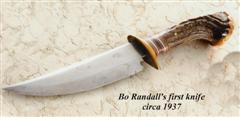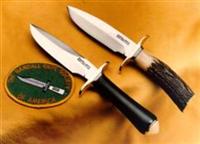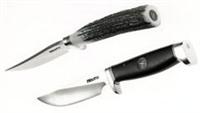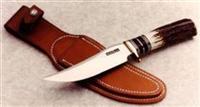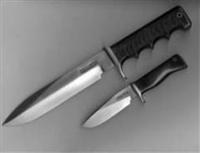For the record, this is what I think; by 1956 at the latest, ‘Bo’ Randall’s local sheath maker Clarence Moore, his ‘go to guy’ for low volume custom, first article, and prototype sheaths was out of the picture. Seeking a local maker for these types of special projects, it’s likely that ‘Bo’ gave a fair number of area based sheath makers a chance to prove themselves...
In part due to a need for easy access, quality issues, price point per sheath, ability to deliver sheaths on short notice, or some combination of the above probably weeded out most of these sheath makers. But, the need for a local sheath maker hadn’t gone away...
The H.H. Heiser company, located far away in Colorado was having its own problems, the ownership of the company having exchanged hands several times in the years leading up to 1960. This situation may or may not have complicated deliveries of standard sheath models, but most certainly impacted their ability to deliver on any of the special project requirements in a timely fashion...
So, by 1959 RMK’s needs may have left them in a position whereby they were forced to take whatever they could get with regards to locally produced sheaths. Luckily, this was a slow period of sales, and they probably had a fairly large number of sheaths in stock...
Thus, based on slow sales, and fair number of sheaths on hand, Jim Stockman, and others, could have taken up much of the slack – with mixed results. Personally, I would believe that by 1961 Stockman’s sheath quality would have improved quite a bit. But, by 1961 business was picking up, orders from Heiser had probably slowed, and the need for a local sheath maker had become critical...
I am firmly convinced that the majority of Jim Stockman’s regular production sheaths – those patterned directly from separated Heiser sheaths, were produced in 1961. Further, that the number was fairly small, probably 300 to 400 in total, and that the quality was somewhat less finished than the original Heiser sheaths they were patterned after...
Usually defined by the use of reddish colored, thinner harness leather with a smoother look, these sheaths differed from Heiser versions by virtue of cut, finish, stitching, and overall appearance; Stockman standard RMK production sheaths, sheaths such as the one referenced in the original post, are similar, yet very different from those that they were patterned from...
This is where Maurice Johnson came into the picture; I believe that based on the sheer number of Johnson ‘Brown Button’ sheaths known to exist (and countless unknown), and the known introduction of the replacement nickel plated baby-dot snaps in late 1963, that it stands to reason that Maurice Johnson started making sheaths for RMK in 1961...this is what I wrote in our book...
On a side note – I also think the last sheath deliveries from Heiser were unmarked, and that the RMK sheath stamp was used on the last deliveries of both Heiser and higher quality Stockman sheaths. In addition, that these sheaths were stamped at the Randall Shop; that the stamp use preceded Johnson’s association with RMK; and that Johnson initially stamped his sheaths perpendicularly, as had the Randall Shop...
Thus, during 1961, and possibly for a few months leading up to and after, unmarked and horizontally stamped sheaths for standard RMK production could have conceivably been made by at least three different sheath making sources.
That’s my thoughts on the matter; as always, your mileage may vary...



